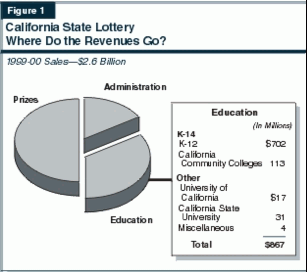

California State Lottery. Allocation for Instructional Materials.
Background
The Lottery. Since 1985, the state has operated the California State Lottery. Revenues from the lottery are allocated as follows:
The amount allocated to public education is distributed, based on student enrollment, to K-14 public schools (K-12 school districts and community colleges), the California State University, the University of California, Hastings College of the Law, and specific state departments that provide K-14 education programs. As shown in Figure 1, lottery revenues are currently about $2.6 billion a year. The figure also shows how funds are allocated to education. Under existing law, these funds can be used for any school expense (except for buying property, constructing facilities, and financing research).
Instructional Materials. Local school districts are responsible for providing necessary services and materials--such as teachers, facilities, and instructional materials--to educate children. (Instructional materials consist primarily of textbooks and other reading materials, but also include other items such as computer software, arts and crafts supplies, and maps.) The state currently provides schools almost $600 million each year that must be spent on instructional materials. (This is about $100 per student each year.)

Proposal
This proposition changes the way that a portion of the annual lottery revenues is distributed to public education. Basically, of the future growth in lottery funds, one-half must go to K-14 public schools and be spent on instructional materials. (See box for an example of how this would work.) These funds would be allocated to K-14 schools on a per-student basis.
The proposition would not change the way "base" lottery revenues are allocated to public education. It also would not change the way that the other one-half of growth monies is allocated.
| How the Proposition Would Affect Education Lottery
Funds
The proposition uses fiscal year 1997-98 (that is, July 1, 1997 through June 30, 1998) as the "base year." In that year, the state allocated $780 million in lottery monies to public education. The proposition's impact in any year would depend on the growth in lottery funds since 1997-98. For example, it is estimated that the total 1999-00 allocation to public education will be $867 million. Based on this amount, the formula in the proposition would result in the following:
Therefore, under this example, the proposition would result in the allocation of $43.5 million to K-14 public schools for instructional materials. The allocation of the remaining public education lottery funds ($867 million - $43.5 million = $823.5 million) would not be affected by the proposition. |
Fiscal Effect
This proposition would not affect the total amount of lottery revenues going to public education. As noted above, it would simply earmark a portion of those funds for instructional materials only. In the near term, we estimate this earmarked amount would be in the tens of millions of dollars each year. The annual amount of funds dedicated to instructional materials would depend on changes in the level of overall lottery revenues.